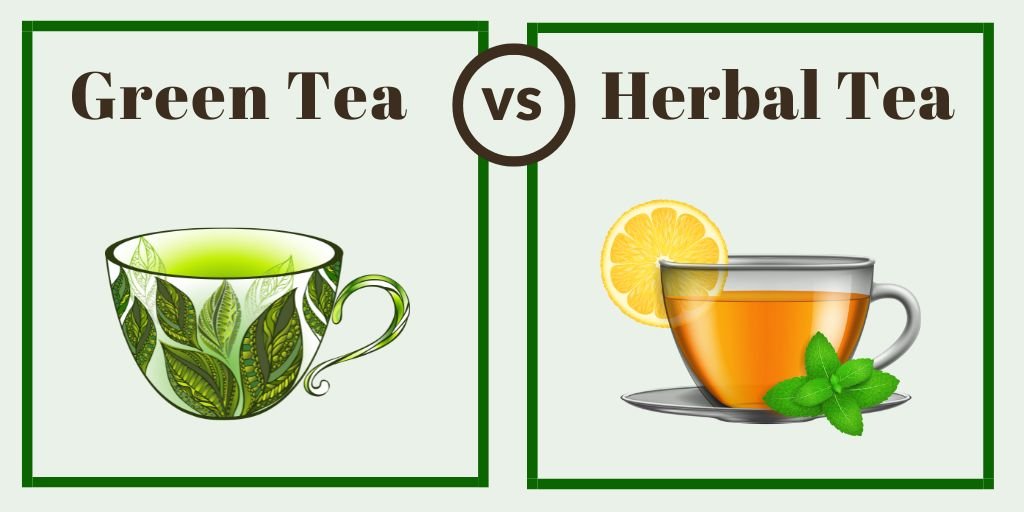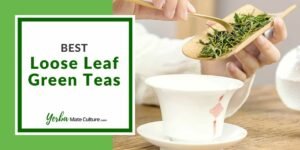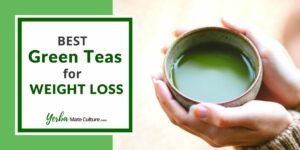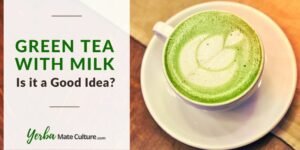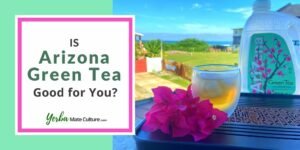I love drinking both green teas and herbal teas. And it’s not just the taste that intrigues me — these teas also have many health benefits confirmed by scientific research.
One interesting aspect is that there are hundreds of varieties to try. My favorites range from Chinese green teas and Japanese matcha to herbal teas like red rooibos tea and energizing yerba mate.
But are green tea and herbal tea the same thing?
The earthy coloring and flavor of green tea can give off an herbal vibe. However, one thing that tea connoisseurs know is that first impressions can be deceiving.
In short, green tea is made from the leaves of the tea plant while herbal teas are made with leaves, flowers, and roots of various plants.
In this guide, I will tell you all about the differences between green tea and herbal tea.
So if you are interested in finding the healthiest and tastiest green and herbal teas and learning how to brew them, keep on reading!
Is Green Tea an Herbal Tea?
Green tea is not considered a type of herbal tea because it’s made from the tea plant. Teas brewed with leaves of the tea plant include green, black, white, and oolong teas, and are often called “real teas”.
Below is an infographic with the key differences between green tea and herbal tea:
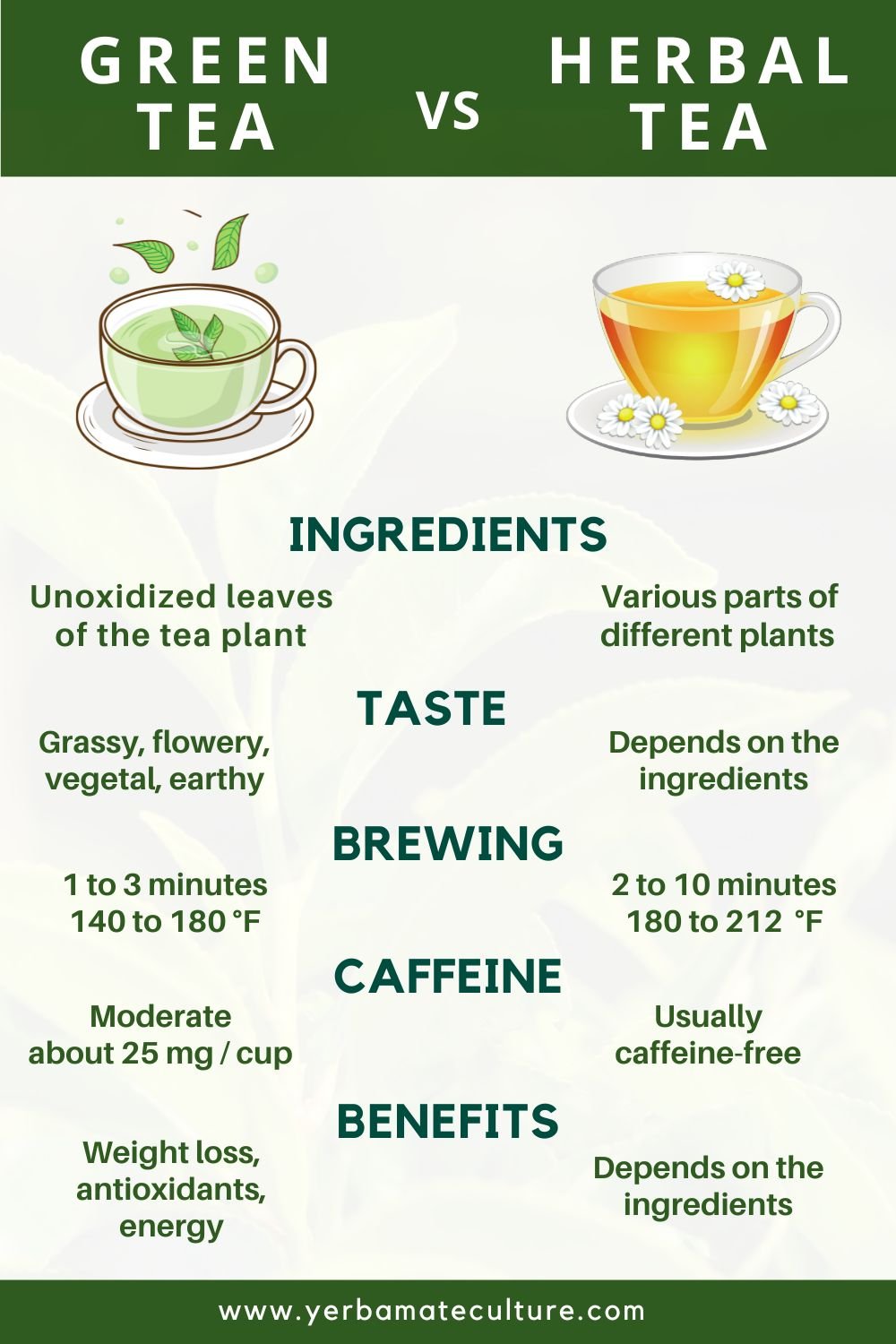
Think of green tea more as a “cousin” of herbal teas — these beverages might have some similarities but the terms should not be mixed up.
However, you can mix green tea with various herbal ingredients. One common example is green tea with mint.
What Is Green Tea?
Green tea is a drink brewed with unoxidized leaves of an evergreen shrub called Camellia Sinensis or tea plant.
Leaves from the same plant can also be used to make black, white, oolong, and pu’erh tea. What distinguishes green tea from those teas is that leaves used for green tea have not undergone the processes of withering and oxidation.
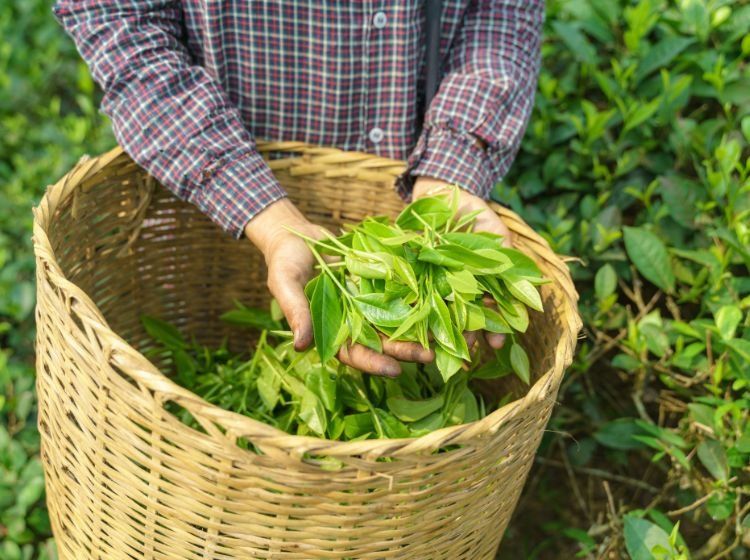
Leaves used to make green tea are carefully harvested by hand. Newly plucked leaves are then preserved with heat.
By contrast, leaves intended for black tea are left to oxidate prior to the drying process.
Processing for green tea can differ based on the style of green tea being produced. The stem is typically separated and discarded to ensure that tea consists purely of leaves.
In Japan leaves intended for green tea are generally dried with steam. In China, the leaves are generally processed using dry-heat drums.
What Are Herbal Teas?
Herbal teas are tisanes made with bark, roots, seeds, fruit pieces, flowers, and leaves of various plants.
Many people think that herbal teas should not be called tea at all because they are not brewed with leaves from tea plant.
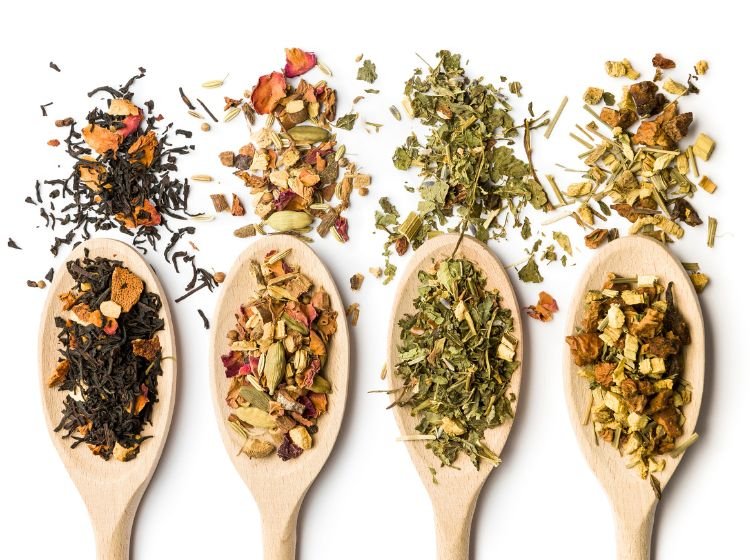
Technically, only teas made from Camellia sinensis leaves are true teas.
The term herbal tea can actually refer to any herbal drink brewed with a variety of natural ingredients. Some well-known examples are ginger tea, mint tea, and chamomile tea which are often used as natural remedies.
Green Tea vs Herbal Tea: Main Differences
Green tea and herbal tea have both been used for medicinal and spiritual purposes for centuries. Both are also satisfying and delicious.
You can also serve both options hot or cold!
However, there are as many differences as there are similarities when it comes to these tea cousins.
Here’s a look at the main differences between green tea and herbal tea:
1. Ingredients
The major difference between green tea and herbal tea comes down to the use of ingredients.
Green tea is always brewed with Camellia sinensis leaves.
Herbal teas can be made with flowers, spices, fruit peels, and other natural ingredients to create different types of healthy and flavorful tisanes.
One tea that straddles the line a bit between green tea and herbal tea is jasmine green tea. Jasmine green tea is true green tea with jasmine flowers added for flavor and fragrance.
2. Taste
The taste of green tea is usually described as grassy, flowery, and earthy.
But different types of green teas often have distinct tastes ranging from light and floral Chinese green teas to Japanese greens with sweet and slightly seaweed-like notes.
Herbal teas can taste like a million different things depending on what it’s made of. The flavors can range from floral and citrusy to sweet and earthy.
In fact, a common purpose of herbal teas is to provide a flavor experience.
The easy part about shopping for herbal tea is that the flavor of the tea is usually right there in the name.
Oranges, lemons, raspberries, and apples are commonly used as flavor bases for herbal teas. Cinnamon, ginger, and other spices are also typically used for herbal teas.
The bottom line is that a shelf of herbal teas creates a garden full of fruity, spicy, bitter, subtle, or bold flavors.
3. Brewing Process
There are two main differences in brewing green teas and herbal teas. Green tea should be generally steeped in lower temperatures and for a shorter time compared to herbal teas.
Water Temperature
Most green teas should be steeped in water that is about 170 to 180 degrees Fahrenheit (77 to 82 Celcius). Some varieties, like Japanese Gyokuro tea, are brewed in even lower temperatures.
Using boiling hot water will usually result in bitter-tasting green tea.
Herbal teas are often brewed in boiling hot water to extract the maximum amount of flavor and beneficial compounds.
However, there are some exceptions. For example, yerba mate tea should not be steeped in boiling hot water because it will taste bitter.
Steeping Time
Green tea can usually be properly steeped in one to three minutes.
Most herbal teas take about 5 to 10 minutes to release their full flavor. However, herbal teas with classically bitter ingredients must only be steeped for 60 seconds to avoid an overly bitter cup.
It’s always wise to read labels to get the best results when steeping green tea or herbal tea.
4. Caffeine Content
The caffeine content is one of the biggest differences between green tea and herbal tea.
An average 8-ounce cup of brewed green tea has about 25 milligrams of caffeine.
That’s about one-quarter of the caffeine content of a cup of standard black coffee.
However, green tea could have anywhere from 20 to 40 milligrams of caffeine depending on what kind of tea you use and how you brew it.
Most herbal teas are naturally free of caffeine.
That’s because they are made with plants that, unlike the tea plant, don’t contain any caffeine. But there are some exceptions.
Here are a few herbal teas that contain caffeine:
- Yerba mate
- Guayusa
- Yaupon Holly
- Guarana
Yerba mate is the most popular caffeinated herbal tea. I like this herbal drink so much that I even named this website after it!
The amount of caffeine in yerba mate is much higher compared to green tea. I often use it to increase focus and efficiency while working or as an energy booster before exercising.
5. Health Benefits
Most green teas and herbal teas are packed with health benefits!
Green tea is known for its antioxidant compounds that may help with everything from burning fat to preventing cancer.
A 2022 study found that green tea can promote gut health, lower blood sugar, and reduce risks for metabolic syndrome. Meanwhile, a 2020 review confirmed that green tea may help to prevent certain cancers.
Yet another 2020 study found that green tea may protect the brain from aging, improve cognition, and reduce the risk of developing Alzheimer’s.
All of this comes on top of other studies that have linked green tea with reduced risk for heart disease, better oral health, and many more benefits.
Herbal teas also impress with their various health benefits from boosting immunity and aiding in weight loss to improving heart health.
Of course, the health benefits of herbal teas can be a little harder to pin down simply because there are so many different ingredients that can be used.
One of the most obvious benefits of drinking herbal tea is that it offers a great way to stay hydrated!
Below are some popular herbal teas with amazing benefits:
- Ginger tea is great for improving digestion, relieving acid reflux, and alleviating cough and flu.
- Chamomile tea famously induces relaxation by calming the nervous system.
- Peppermint tea has been shown to provide relief for people with indigestion and irritable bowel syndrome.
- Rooibos tea can help with relieving allergies and improving skin health.
You can also try some ready-made blends like Yogi Bedtime Tea or Chupa Panza Tea.
Green Tea vs Herbal Tea FAQ
Which one is healthier, herbal tea or green tea?
There is no clear answer to which one is healthier, green tea or herbal tea. This depends on what is your specific purpose and what type of green tea or herbal tea you are using.
For example, if your goal is to burn fat, high-quality green tea is a great option. But if you are aiming to improve digestion, then ginger tea might be a better option.
Does herbal tea have caffeine?
Most herbal teas don’t contain any caffeine. However, there are some exceptions like yerba mate and guarana.
Can I mix herbal tea and green tea?
Yes, you can create your own delicious and healthy blends by mixing green tea with different herbal ingredients. Some great options are ginger root, peppermint leaves, and lemon peel.
While green tea and herbal tea aren’t interchangeable, there’s no need to spark a competition between the two.
In fact, enjoying both in your diet can be a great way to get as many health benefits as possible.
Herbal tea can be a great option for “tea addicts” who want something to sip on between multiple cups of green or black tea throughout the day!

